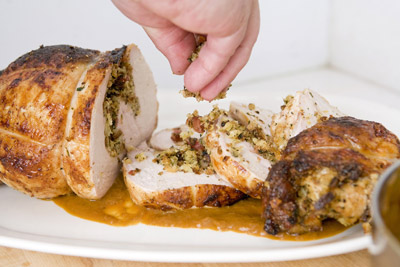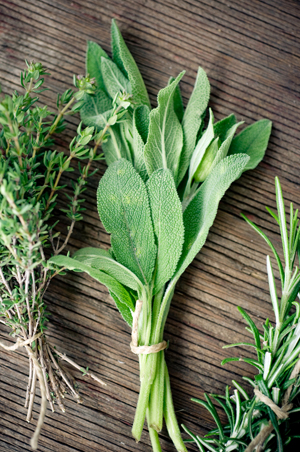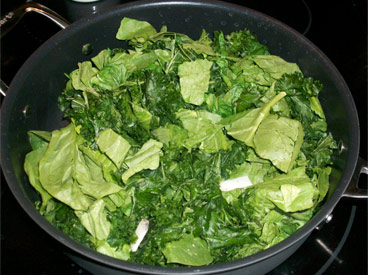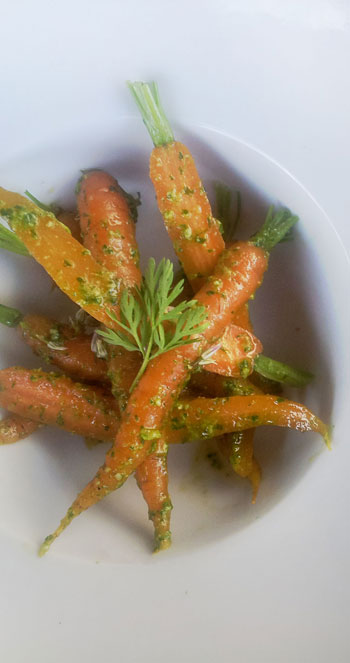Shake Up Your Thanksgiving Dinner
If you’re tired of your same old stuffing recipe, need a new twist on turkey, or want to get more creative than slicing canned cranberry sauce, then take a look at these fall-flavored recipes we’ve curated from our archive.
You can also sprinkle some history into your Thanksgiving traditions with Harry Truman’s ham recipe and Norman Rockwell’s oatmeal cookie recipe. We found the ham recipe tucked in the September 22, 1945, issue of the Post. While President Truman gets the headline, a closer read reveals it to be Mrs. Truman’s recipe.

“Spiced” Cider
By Post Editors
Published October 20, 2009
- 1.5 part Tuaca or Frangelica
- 1 part apple cider
- Garnish with whipped cream and cinnamon
For party-sized batch:
- 1 (750ml) bottle Tuaca (can replace with Frangelica)
- 1 pint apple cider
- 4 cinnamon sticks
Mix together and serve with whipped cream.
Curry Deviled Eggs
By Heather Ray
Published June 25, 2010

Makes 12 servings (2 halves per person)
- 12 large eggs, hard-boiled
- 1/2 cup nonfat, plain Greek yogurt
- 2 teaspoons curry powder
- 1 tablespoon Dijon mustard
- 1/2 teaspoon garlic powder
- 2 tablespoons green onion, finely chopped
- 2 tablespoons celery, finely chopped
- 1/2 teaspoon lemon juice
- Salt and pepper, to taste
When cool, peel shells from hard-boiled eggs. Carefully cut each egg in half, lengthwise. Gently scoop out yolks and place in bowl. Add all remaining ingredients and mash together. Taste for seasoning and adjust accordingly. Using a pastry bag or spoon, fill each egg white with mixture. Refrigerate until ready to serve.
Harry Truman’s Baked Ham
By Martha Ellyn Slayback
Published September 22, 1945

Put ham in covered pan half full of water and boil two hours. Pour off some of the water, add a quart of pineapple juice and put in medium hot stove to bake. Bake about an hour; then remove from oven, take off top skin and cover ham with a thick layer of brown sugar to which prepared mustard has been added. Stick thickly with whole cloves, return to oven and bake until done—about two hours. During the final fifteen minutes of baking, put pineapple slices into the pan, and garnish the ham with the pineapple before serving.
Emeril Lagasse’s Turkey Roulade with Peach and Sage Gravy
By Emeril Lagasse
In Issue November/December 2012
(Makes 6 to 8 servings)

Ingredients
- 4 quarts water
- 1 cup packed light or dark brown sugar
- ¾ cup kosher salt, plus more for seasoning roulade
- 1 7-pound whole turkey breast, skin on, deboned
- 4 cups coarse fresh breadcrumbs (from a loaf of French or Italian bread)
- 8 ounces bacon, chopped and cooked until crisp, fat reserved (or substitute olive oil)
- 2 tablespoons unsalted butter, melted
- 2 tablespoons chopped garlic
- ½ cup chopped fresh parsley
- 1 teaspoon Emeril’s Original Essence or Creole Seasoning, plus more for seasoning roulade
- ¼ cup olive oil
- Freshly ground black pepper
- Peach and Sage Gravy (Click here for recipe.)
Directions
- Combine water, brown sugar, and salt in 2-gallon or larger stockpot, and whisk until sugar and salt have dissolved. Place turkey breast in stockpot and refrigerate for 8 hours.
- Remove turkey breast from brine, and pat dry with paper towels. (At this point you can proceed with recipe or refrigerate turkey up to 1 day until ready to cook.)
- Preheat oven to 350° F.
- Cut three lengths of kitchen twine to 32 inches, and lay across cutting board. Making sure skin is pulled down to cover as much of breast meat as possible, lay turkey breast, skin side down, on top of strings. Cover turkey with parchment paper or plastic wrap, and pound with heavy mallet or bottom of cast-iron skillet until thickest part of breast is no more than 2 inches thick.
- In large mixing bowl, use rubber spatula to combine breadcrumbs, bacon, ¼ cup reserved bacon fat, butter, garlic, parsley, and Original Essence or other seasoning.
- Lightly season turkey breast with Original Essence. Pack stuffing mixture tightly into 1-cup measure, and then empty stuffing onto middle of breast. Repeat two more times. Roll breast up as tightly as you can to form a cylinder, and use twine to tie breast together in three places. Snip off extra length of twine. (You can also tie twine vertically around breast, tucking in flaps at ends, if necessary to keep stuffing inside.) Brush olive oil all over roulade, and season lightly with Original Essence, kosher salt, and pepper.
- Heat large skillet or ovenproof roasting pan over medium-high heat. When hot, place turkey roulade into pan and sear until golden brown on all sides. Transfer pan to preheated oven and cook uncovered until center reaches an internal temperature of 155° to 160°F when tested with instant-read thermometer, 60 to 90 minutes. Remove turkey from oven and let rest for 20 minutes before carving.
- Remove strings and slice roulade crosswise into ½-inch-thick slices. Serve with Peach and Sage Gravy.
Peach and Sage Gravy
By Emeril Lagasse
Published October 17, 2012
(Makes about 3 cups)

Ingredients
- 2 tablespoons olive oil
- ¼ cup finely minced shallots
- 2 teaspoons minced garlic
- ½ cup white wine vinegar
- 4 cups turkey stock, chicken stock, or canned low-sodium chicken broth
- ¾ cup peach preserves
- 2 tablespoons unsalted butter, at room temperature
- 2 tablespoons all-purpose flour
- ¼ teaspoon salt
- ¾ teaspoon freshly ground black pepper
- ⅟₃ cup fresh sage leaves
Directions
- Set 2-quart saucepan over medium heat and add olive oil. Once oil is hot, add shallots and garlic and sauté, stirring often, until shallots are fragrant and lightly caramelized, about 1 minute.
- Add white wine vinegar and cook until nearly completely reduced, about 1 minute.
- Add stock and preserves, and raise heat to high. While stock is coming to boil, combine butter and flour in small bowl and, using back of spoon, blend to form smooth paste.
- Add butter-flour paste to stock and use whisk to stir in, making sure it is well incorporated. Bring gravy to boil, season with salt and pepper, and reduce heat to simmer. Cook until gravy has reduced by one quarter, about 20 minutes.
- Remove pan from heat and add sage leaves to gravy. Allow flavors to steep for about 3 minutes, and then strain gravy. Serve gravy with slices of turkey roulade (click here for recipe).
Walnut Mushroom Pâté
Ingredients
- ½ cup chopped walnuts
- ¼ ounce dried porcini or wild mushrooms
- ⅓ cup hot tap water
- 8 ounce crimini mushrooms, stemmed and quartered
- 8 ounce white mushrooms, stemmed and quartered
- ½ cup coarsely chopped shallots
- 2 garlic cloves, coarsely chopped
- 1 tablespoon extra virgin olive oil
- 1 tablespoon dried thyme
- 2 teaspoons reduced-sodium soy sauce
- Salt and freshly ground black pepper
- 2 tablespoons chopped flat-leaf parsley, for garnish
Directions
- Preheat oven to 350°F.
- Spread walnuts on baking sheet. Stir and toast 5 minutes, until nuts are colored and fragrant. Transfer nuts to plate, cool and set aside.
- In small bowl, soak dried mushrooms in water until soft, 20–30 minutes. When soft, squeeze mushrooms until dry, catching liquid in small bowl. Strain liquid through paper coffee filter or fine strainer and set liquid aside. Coarsely chop soaked mushrooms and set aside.
- In food processor, combine half fresh mushrooms with shallots, garlic, and half soaked wild mushrooms. Pulse to chop very fine, 20 times; take care not to overprocess. In large skillet, heat oil over medium-high heat. Add chopped mushroom mixture, mixing to combine with oil. In food processor, finely chop remaining fresh and soaked mushrooms, then add to pan. (Do not clean out food processor.) Cook until mushrooms look wet, 8-10 minutes, stirring often. Add thyme, soy sauce, and reserved mushroom liquid. Continue cooking until mushrooms are golden and cling together, 8 minutes. Set aside.
- Add walnuts to food processor, and then cooked mushrooms. Pulse until mushroom-walnut mixture is nubbly; do not purée. Turn warm pâté into serving bowl and season to taste with salt and pepper. Or season pâté and cool to room temperature, cover tightly, and refrigerate for up to 5 days. Garnish with parsley and serve with toast points, crackers, or pita chips.
Nutrition Facts
Per Serving (1 tablespoon)
Calories: 25
Total fat: 2 g
Saturated fat: 0 g
Carbohydrate: 2 g
Fiber: 0 g
Protein: 1 g
Sodium: 10 mg
Carrot Top Pesto
By Anna Buss of Cookin’ the Market
Published June 28, 2013
(Serves 4–6)
Ingredients
- 1 bunch young carrots
- 1 cup arugula (optional)
- ¼ cup almonds in shell
- 1-2 teaspoons green garlic
- ½ cup olive oil
- Juice of ½ lemon
- Salt and pepper to taste
Directions
- Remove greens from carrots.
- Blanch greens in salted water until tender and bright green.
- Remove greens from water and shock in ice bath. Squeeze out water and set aside.
- Repeat steps 2 and 3 with arugula, and then with carrot bottoms.
- Blanch almonds until shells become loose. Remove almonds from water and allow to cool. Shell and set aside.
- Combine carrot greens, arugula, garlic, almonds, olive oil, and lemon in food processor. Blend until smooth, adding salt and pepper to taste.
- Toss pesto with blanched carrots, and serve. Pesto can also be tossed with your favorite spring salads, pasta, and veggies, or spread it on a sandwich.
Recipe created by Mario Hernandez, program coordinator and market chef for Cookin’ the Market
Christy’s Greens
By Elizabeth Murphy of West End Farmers Market/International Institute St. Louis
Published September 20, 2013

Serve Christy’s Greens over quinoa for a flavor-filled lunch.


Ingredients
- 1 head mustard greens
- 2 cups kale
- 1 cup fresh spinach
- ½ head iceberg lettuce
- 1 turnip
- 4 medium cloves garlic
- 2 Tablespoons olive oil
- ½ teaspoon salt
- ½ teaspoon ground black pepper
Directions
- Remove hard stems from kale and mustard greens (leave stems if desired).
- Stack leaves on top of each other. Use knife to slice mustard greens, spinach, and kale into ¼-inch strips. Slice iceberg lettuce, but keep separate from other greens.
- In large bowl filled with cold water, add cut greens. Allow dirt to settle to bottom of bowl. Lift greens out of bowl. Shake off excess water. Repeat step with lettuce.
- Peel and mince garlic. Peel and slice turnip. Set aside.
- In a large skillet over medium-high heat, heat oil.
- Add mustard greens, spinach, and kale.
- Stir greens until wilted, about 1-2 minutes.
- Reduce heat to medium. Add garlic and turnip. Cook until greens are soft and excess water is gone, about 5-7 minutes. Add iceberg lettuce, cook for 1-2 minutes.
- Season with salt and pepper. Serve immediately.
Microbrew-Braised Rutabagas
By Post Editors
Published January 31, 2013
(Makes 6 servings as a side dish)

Ingredients
- 2 tablespoons unsalted butter
- 1 tablespoon extra-virgin olive oil
- 1 large yellow onion, about 12 ounces, thinly sliced
- 2 tablespoons firmly packed dark brown sugar
- 4 teaspoons kosher or fine sea salt
- ½ teaspoon ground Aleppo chile
- ¼ teaspoon freshly ground black pepper
- ¼ teaspoon ground cinnamon
- 2 pounds rutabagas, ends trimmed, peeled, and cut into ½-inch wedges
- One 12-ounce bottle porter-style beer
- 1½ cups canned low-sodium vegetable broth
- 2 teaspoons finely chopped fresh oregano
- 2 teaspoons finely chopped fresh thyme
Directions
- In Dutch oven or other heavy pot, melt butter with oil over medium-low heat until butter is foamy. Add onion and stir to coat evenly. Cover and cook until onion begins to soften, about 5 minutes. Uncover and continue to cook, stirring frequently, until onion is evenly golden brown and caramelized, about 20 minutes.
- Add brown sugar, salt, Aleppo pepper, black pepper, and cinnamon and stir constantly until brown sugar has melted and spices are aromatic, about 1 minute. Add rutabagas and stir to coat. Add beer and stock, pressing down on vegetables to submerge them. Liquid should just cover vegetables. If it doesn’t, add more stock or water as needed. Increase heat to medium-high and bring to a boil. Reduce heat until liquid is at a simmer, cover, and cook for 20 minutes. Stir in oregano and thyme, re-cover, and continue to cook until rutabagas are fork-tender, 5 to 10 minutes more. Using a slotted spoon, transfer rutabagas and onions to serving bowl, cover, and keep warm.
- Increase heat to high and boil braising liquid, stirring occasionally, until it reduces to about ¼ cup and has thickened to syrup consistency, 10 to 15 minutes. Reduce the heat to low, return rutabagas and onion to pan, and toss to coat in sauce. Heat until vegetables are hot, and then taste and adjust the seasoning. Serve immediately.
Deep Dish Cranberry Pie
By Post Editors
Published November 21, 2009

(Makes 8 to 10 servings)
Crust:
- 1 1/4 cup gluten-free flour
- 6 tablespoons unsalted butter, chilled and cut into small pieces
- 2 tablespoons vegetable shortening, chilled
- 1/4 teaspoon salt
- 4 tablespoons ice water, or more as needed
Place gluten-free flour and salt in medium bowl. Using pastry cutter or 2 knives, cut in butter and shortening until mixture resembles coarse crumbs. Add 2 tablespoons ice water, mix just until incorporated. Continue adding ice water as needed, 1 tablespoon at a time, until dough is smooth. Form dough into disk, wrap tightly with plastic wrap. Refrigerate 1 hour.
Preheat oven to 400 F. Remove dough from refrigerator, place on lightly gluten-free floured surface (we use an extra large Silpat-a sort of “rubber” nonstick mat, which really helps prevent dough from sticking to bottom surface). Lightly flour surface of dough with gluten-free flour. Roll pastry to large round, about 12 inches in diameter. Transfer to deep 9-inch pie plate, trim to within 1/2 inch of pan, crimp decoratively. If outer edges break off before folded under and crimped, just use excess dough. Press onto outer edge to form an even edge, then crimp. Prick with fork, cover. Refrigerate 20 to 30 minutes. Reserve any excess dough, reform into ball. Bake 15 to 30 minutes or until light brown. Remove form oven, let cool completely on wire rack.
Filling:
- 1 cup water
- 1 1/2 cups dried cherries
- 1 1/4 cups dried cranberries
- 1 (12 ounce) package fresh cranberries
- 1 1/4 cups granulated sugar
- 3 tablespoons gluten-free flour
- Zest of 1 lemon
- 1 tablespoon milk
- 1 tablespoon sugar
- 1 teaspoon cinnamon
In small saucepan, bring 1 cup water to simmer. Add dried cranberries and cherries. Remove from heat. Cover, let stand 20 minutes.
In large bowl, stir together fresh cranberries, undrained dried cherry-cranberry mixture, 1 1/4 cups sugar, gluten-free flour, and lemon zest. Pour mixture into prepared pie crust. Preheat oven to 375 F.
Roll out excess dough. Using small knife, cut out leaf shapes. Using tip of knife, vein leaves without cutting through dough. Using spatula, remove “leaves” and place on top of pie in decorative fashion. Using pastry brush, brush “leaves” with milk. Sprinkle top with sugar and cinnamon.
Cover pie edges with foil. Bake 45 to 50 minutes or until juices bubble and top of “leaves” are lightly browned. Transfer pie to cooling rack to cool.
Sauce:
- 1 cup crème fraîche
- 3 tablespoons wildflower honey
In medium bowl, whisk together crème fraîche and honey. To serve, place slice of pie on plate, drizzle sauce over top.
Recipe from Glutenfreeda Online Magazine and Recipe Book.
Norman Rockwell’s Oatmeal Cookies
By Corey Michael Dalton
Published December 29, 2011

Ingredients
- 1 stick butter
- 1 cup light brown sugar
- 1/2 cup granulated sugar
- 1 teaspoon vanilla
- 1/4 cup water and 2 eggs well beaten
- 1 teaspoon salt
- 1 cup flour, sifted
- 1/2 teaspoon baking soda
- About 1 cup oatmeal
- Chopped nuts (walnuts preferred)
Directions
Mix in order and drop on baking sheet. Bake 400° 7 to 8 minutes. Then run under broiler to brown.
Mary McCartney’s Just Desserts: Plum and Pear Crumble
Crumble is delicious and I like to think of it as deceptively guilt-free. It packs a whopping fruity punch and is also very versatile. You can play around with the fruit combinations, using apples and blackberries instead, or berries, depending on what is in season. This dessert can be serve on its own, but is also great with custard, whipped cream, or ice cream.

Plum and Pear Crumble
(Makes 4 servings)
Ingredients
For the filling:
- 8 ripe plums, cut in half and pitted
- 4 ripe but firm pears, cored and cut lengthwise into quarters
- ½ cup packed light brown sugar
- 1 teaspoon ground cinnamon
For the crumble:
- ⅔ cup all-purpose flour
- 1 cup rolled oats
- ½ cup ground almonds
- ¼ cup packed light brown sugar
- 7 tablespoons butter, chilled and cut into cubes
Directions
- Preheat the oven to 375°F.
- Cut sliced plums and pears into bite-sized pieces and put them into a medium baking dish (about 10 inches).
- Sprinkle the brown sugar and the cinnamon evenly over fruit and stir together well.
- To make the crumble, put flour, oats, ground almonds, and brown sugar into medium mixing bowl. Then add butter and gently rub these ingredients together using your fingertips, until mixture resembles coarse breadcrumbs.
- Scatter crumble evenly over prepared fruit in baking dish.
- Bake for 45 minutes, until topping is golden and crisp, and serve warm or at room temperature.
Photo of Mary McCartney : Photo © by Simon Aboud
Reprinted with permission from FOOD: Vegetarian Home Cooking © 2012 by Mary McCartney, Sterling Epicure, an imprint of Sterling Publishing Co., Inc. Photography by Mary McCartney
Microbrew-Braised Rutabagas
“Who knew? With a little experimentation, I discovered rutabagas and beer are made for each other. Add this side dish to a wintertime menu that features roast pork, grilled sausages, braised brisket, or even roast chicken. A porter-style beer works best, delivering a rich malt flavor without a bitter finish,” writes Diane Morgan author of Roots: The Definitive Compendium with more than 225 Recipes.
Microbrew-Braised Rutabagas
(Makes 6 servings as a side dish)

Ingredients
- 2 tablespoons unsalted butter
- 1 tablespoon extra-virgin olive oil
- 1 large yellow onion, about 12 ounces, thinly sliced
- 2 tablespoons firmly packed dark brown sugar
- 4 teaspoons kosher or fine sea salt
- ½ teaspoon ground Aleppo chile
- ¼ teaspoon freshly ground black pepper
- ¼ teaspoon ground cinnamon
- 2 pounds rutabagas, ends trimmed, peeled, and cut into ½-inch wedges
- One 12-ounce bottle porter-style beer
- 1½ cups canned low-sodium vegetable broth
- 2 teaspoons finely chopped fresh oregano
- 2 teaspoons finely chopped fresh thyme
Directions
- In Dutch oven or other heavy pot, melt butter with oil over medium-low heat until butter is foamy. Add onion and stir to coat evenly. Cover and cook until onion begins to soften, about 5 minutes. Uncover and continue to cook, stirring frequently, until onion is evenly golden brown and caramelized, about 20 minutes.
- Add brown sugar, salt, Aleppo pepper, black pepper, and cinnamon and stir constantly until brown sugar has melted and spices are aromatic, about 1 minute. Add rutabagas and stir to coat. Add beer and stock, pressing down on vegetables to submerge them. Liquid should just cover vegetables. If it doesn’t, add more stock or water as needed. Increase heat to medium-high and bring to a boil. Reduce heat until liquid is at a simmer, cover, and cook for 20 minutes. Stir in oregano and thyme, re-cover, and continue to cook until rutabagas are fork-tender, 5 to 10 minutes more. Using a slotted spoon, transfer rutabagas and onions to serving bowl, cover, and keep warm.
- Increase heat to high and boil braising liquid, stirring occasionally, until it reduces to about ¼ cup and has thickened to syrup consistency, 10 to 15 minutes. Reduce the heat to low, return rutabagas and onion to pan, and toss to coat in sauce. Heat until vegetables are hot, and then taste and adjust the seasoning. Serve immediately.
Recipe excerpted from Roots by Diane Morgan. Photographs by Antonis Achilleos. (Chronicle; October 2012; $40.00/Hardcover: ISBN-13: 978-0811878371). Chroniclebooks.com.


